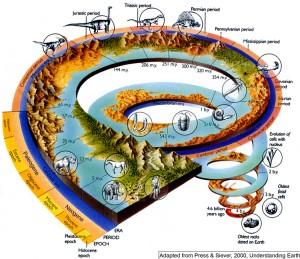One of the great questions that Palaeontology poses is how did life and the Earth co-evolve together? This is especially so in the case of early life during the Phanerozoic period (540 million years ago until now), when complex multi-cellular life took off and ultimately came to dominate the planet. When one considers the vast number of potential factors involved in this, it can be pretty overwhelming. To start off with, you have organisms themselves which adapt through altering their physical appearance and functionality. Driving this, you have the environment and the ecosystems in which organisms dwell. How many parameters can you think off that may have some effect, any effect, on the life of an organism or population of organisms, that could have some impact on evolutionary trajectory? There’s a lot, right? Some of the major environmental factors include oxygen and carbon dioxide concentrations, nitrogen, temperature, humidity. You can find variations of almost any environmental variable nowadays, and correspond it to variability in the local biota. But what about during the Phanerozoic? How much can we still see left preserving this great orchestra of ever-changing life and planet?
Horsedrosaurus, the dinosaur that wanted to be an equid.
The title of this makes no sense, but kind of emphasises the main point of this post. It’s pretty much a summary of a new paper, one on the feeding habits of hadrosaurid dinosaurs. These are the big advanced ornithopods, often considered to be the ‘bland’ lineage of ornithischians, and referred to as the ‘cows of the Cretaceous’. They also happen to be my favourite group of dinosaurs, simply because, with the exception of the more avian theropods, they are the only ones who are vaguely analogous to extant organisms; specifically, ungulates. This means that by comparing certain aspects of their morphology, we can make inferences about their behaviour and lifestyle, which is certainly one of the cooler aspects of Palaeontology. Unfortunately, this new article is published in Science, which means you either have to fork out for it, can’t read it, or have to go to some other media outlet (and let’s face it, no-one does that anymore in the era of blogging, right? Right??) ScienceNOW have been nice enough to cover it here though.
You don’t need to be a Palaeontologist to hunt fossils – they’re right here in London!
If this image below is your idea of fossil hunting, you wouldn’t be far off from the reality. Typically, you have to go to a coastline, quarry, or vast expanse of desert to track anything down.
I currently live in London, so was a bit bewildered when a movie made by Nick Crumpton and starring Imperial College’s own Issy Gilbert (a member of my research group!) showcased the various fossil localities smack bang in the middle of the city!
If you live in London, or ever happen to be in the area, give in to your curiosity and check them out! I don’t recommend smashing things apart with gusto in a rock hammer-wielding frenzy, but do have a look, and catch a glimpse of ancient life encased within an urban environment. It’s the ultimate juxtaposition!
New Palaeontology podcast series
Palaeocast is a little side project I co-run with Dave Marshall and Joe Keating. It’s a new podcast series focusing on Palaeontology (shocking), and about getting the science directly from the scientists. We recognise that science is a process, not a series of facts, and wish to convey this process; the methods, the ups and downs, the snake bites, the everything, and really open up the world of Palaeontology.
We’ve got 4 episodes currently up, and more on the way!
Episode 1: The earliest fossils and the hunt for extra-terrestrial life, with Dr. Leila Battison (NASA)
Episode 2: The giant trilobite, Isotelus rex, with Dave Rudkin (ROM, Canada)
Episode 3: Amber, and parasitism in the fossil record, with Dr George Poinar (OSU, USA)
Episode 4:The fossil forests of ancient gilboa, with William Stein (NYSM, USA)
Please do check them out, and give feedback! If you have any suggestions for future episodes, drop a comment here, and we’ll see what we can do.


